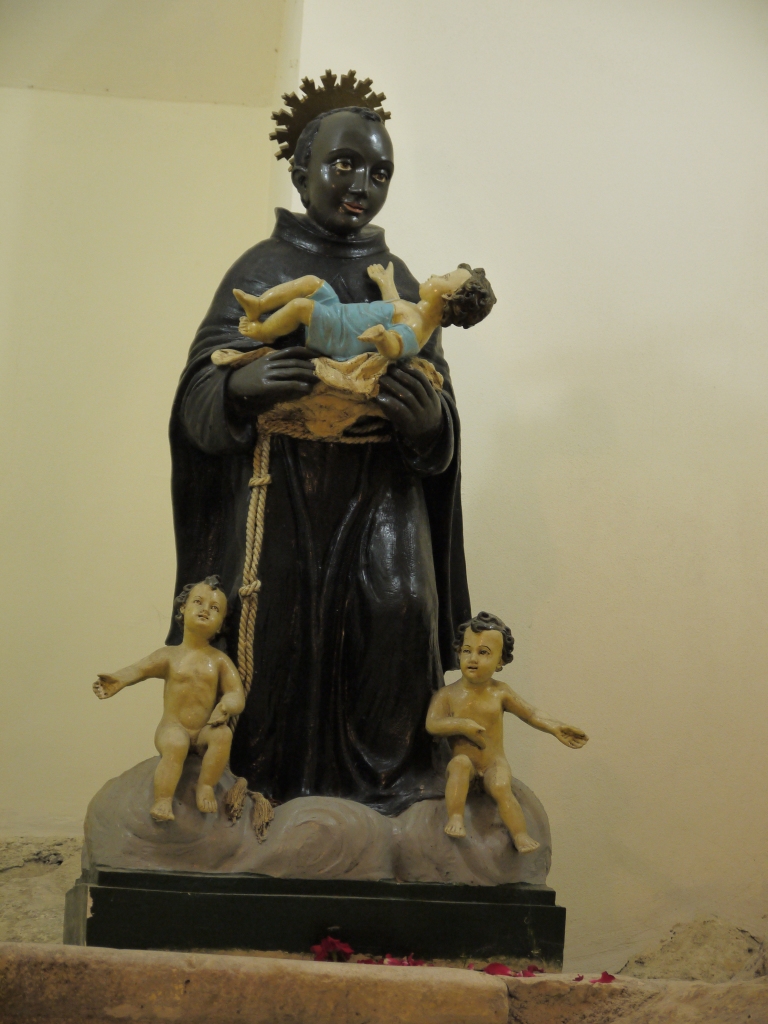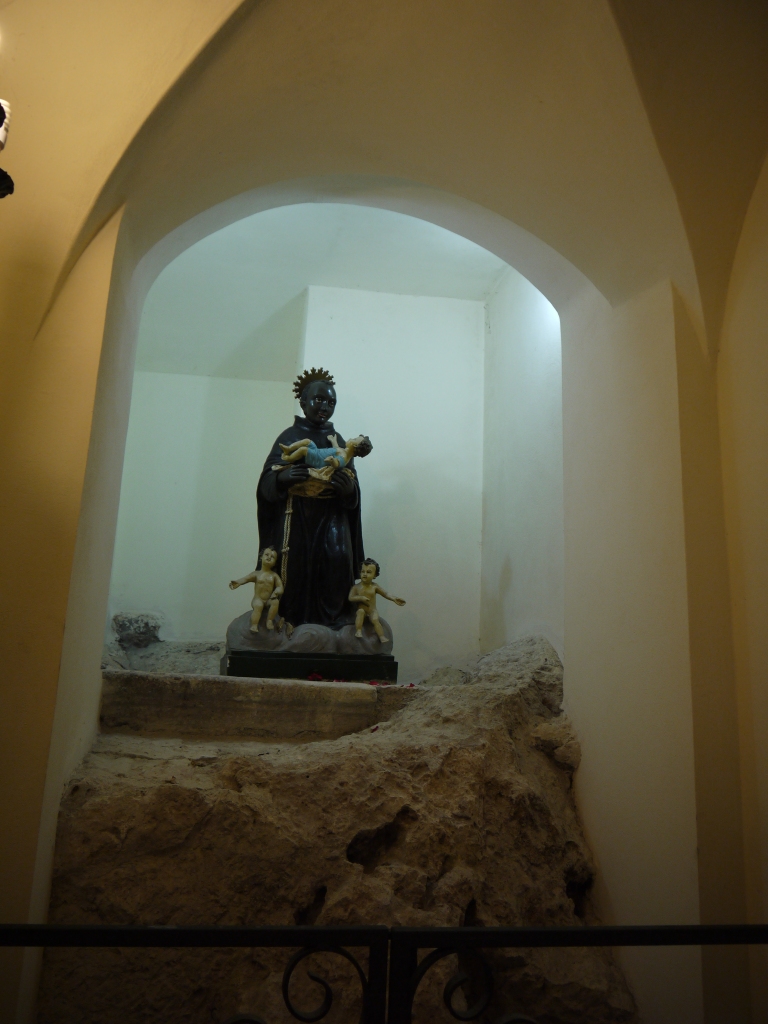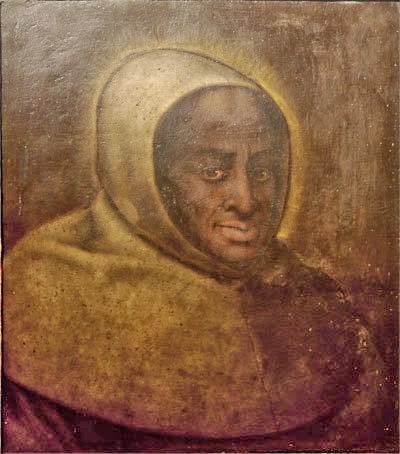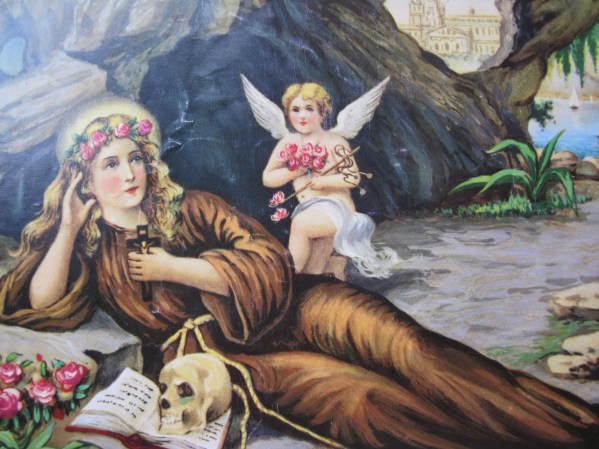Saint Benedict, known as Benedetto il Moro or Benedict the Moor, was born to two black African slaves in Messina, Sicily in 1524. He was also variously called niger, which means black, and ethiops, which means Sub-Saharan African. If I know the Sicilians, they probably called him “Chinese” half the time, too – they’re pretty vague that way.

Sicily was ruled by the Spanish in those days, who engaged in slave trading. When Southern Europe had been ruled by the Africans, they had white European slaves, so I think the Spanish were keen to turn the tables on them. Much of Spain was governed by the Africans for 800 years, and the Spanish had a very difficult and long war when they eventually rose up against them to regain their independence.
Benedetto and his parents were freed at his birth because of their “loyal service,” but they stayed – loyally! – on the same estate, working for meagre wages. Benedetto had a little brother and two younger sisters. The children worked alongside their parents and received no schooling. Benedetto never learned to read or write.

Benedetto was noticed as a caring and generous boy from an early age. He always shared food and what little he had with those less fortunate than himself.
When he was 21 years old, he suffered a racist attack while out in town. His attackers shouted insults and generally showed themselves to be very small-minded. Meanwhile Benedetto’s dignity and restraint attracted the admiration of a great many onlookers. Among them were some monks from the Hermitage of Santa Domenica in Caronia, close to where he lived, who invited him to join them.
The idea of living in a hermitage is that you sneak off and shun society, of course. With Benedetto around, the place was flooded with visitors begging him to perform a miracle for them. He performed some feats of miraculous healing, apparently, which only encouraged more visitors. The place ended up like this:

The other hermits got so fed up with their hermitage not being hermitty any more that they kicked him out.
Luckily he fell in with some religious hermits who lived on Monte Pellegrino on the outskirts of Palermo, who invited him to join them. Surely that would be remote enough for him to get away from his fans?

Monte Pellegrino means “Pilgrim Mountain” and it seems to have been swarming with religious hermits back in medieval times. Saint Rosalia dashed up there as a little girl in the 12th century and hung out in caves. Benedetto lived up there with his band of cave-dwelling hermits for 20 years. Nowadays it is covered in flowering shrubs and inhabited by birds and lots of little darting lizards, but back then there were bears and lions. It was not a camp site for the faint-hearted.
Apparently even the lions didn’t deter Benedetto’s fan club, which consisted of all kinds of big cheeses in the Catholic church who trekked up there to ask his advice before making important decisions. Benedetto eventually became the leader of his little mountain band.
In 1564, when Benedetto was 50 years old, the pope ordered that independent hermits had to join an existing order of friars. Benedetto took his band of holy mountaineers to the Franciscan Friary of St Mary of Jesus in Palermo.
Since he was illiterate, and a layman rather than a priest, he was sent to work in the kitchens. Since so many people still came to him for spiritual guidance however – not just from the friary, but famous and important outsiders, too – he was promoted to being Master of the Novices and then Guardian of the community.
He was very good at making predictions, apparently.
Benedetto predicted that plague would come to Palermo in 1624, exactly 100 years after his birth. He said that the bones of Saint Rosalia would be found up on Monte Pellegrino, where she had lived her life as a religious hermit just as he had lived the first half of his life, and that when the city gave her bones a Christian burial, she would stop the plague and be made patron saint of Palermo.

This prediction came true, and this is why the little statue of Saint Benedetto in my photos was placed in the grotto of Saint Rosalia on Monte Pellegrino.
Benedetto also correctly predicted the exact day and time that he himself was going to die: April 4th, 1589. His body is still in the Friary, displayed very creepily in a Snow-White style glass coffin. On 4th April each year, the coffin coffin is taken out in a religious procession in his honour around town.

Many citizens of Palermo make pilgrimages up Monte Pellegrino in September. Whilst making offerings and saying prayers to Saint Rosalia herself, the patron saint of Palermo, they also remember Saint Benedetto, who gave so many people spiritual guidance in the past.
I am so in love with Sicilian Saints, San Benedetto is a special one, they are all so talented! I so believe there is a book in them and their festas. Thanks so much for sharing your insights Veronica.
LikeLike
I didn’t know there was a book about them. Do you remember the title?
LikeLike
I think he/she means that YOU should write one! I agree. One of my favorite Catholic grade school books was a children’s “lives of the saints”, with lots of gory details
LikeLike
Ha ha!!! yes, the saints most certainly provide gory details!!!
LikeLike
You haven’t got Santa Rosario’s number have you? I’m a sucker for that whole robes and glowing hair combo!
LikeLiked by 1 person
Ha ha ahaaaa! You had better come to Palermo when it’s the Santa Rosalia festival in August. They choose a pretty girl to dress up as her each year! 😉
LikeLiked by 1 person
Great post lots of history and nice photos! Love Palermo have rented apartments three times and stayed in Palermo as home base for three weeks! We visited this site ! A privilege! Love .Palermo!! Thank you for sharing!!!
LikeLike
Thank you! I’m glad you liked the post!
LikeLike
The snow white coffin is just a little on the creepy side. And lions in Sicily? I didn’t know that….
LikeLike
Yes, I find that coffin ultra creepy.
I would love to know when the lions died out. I wonder if the Sicilians ate them??
LikeLike
They eat everything else, why not lions.
LikeLike
Never knew about this saint. When I was a little girl my aunt Rosalia and I went up the mountain for the pilgrimage to the saint but I was too young to understand all of it. I am so glad that you are writing so much info about “My” island. I have learned so much from your own love of the island. I love it. Keep on writing.
LikeLiked by 1 person
Thank you! 😀
LikeLike